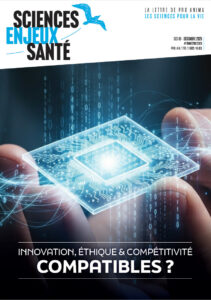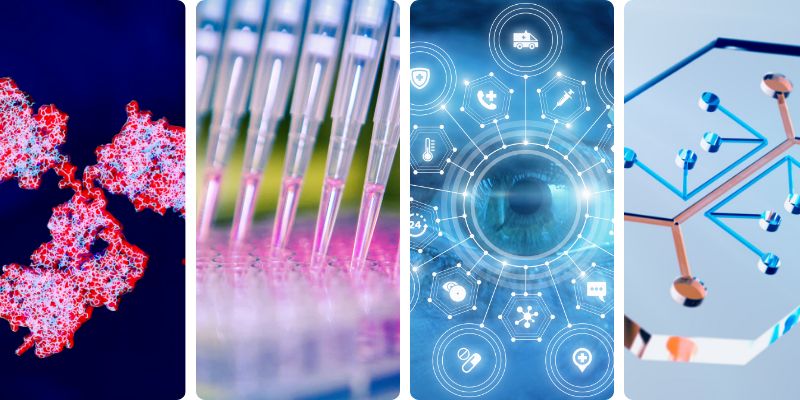
News on non-animal methods
JUNE 23 - 27, 2025
NEWS, REPORTS & POSITION STATEMENTS
1. ECHA updated report on Key Areas of Regulatory Challenge
The European Chemicals Agency (ECHA) has updated its report on Key Areas of Regulatory Challenge with new topics in line with the European Union’s Competitiveness Compass and the Clean Industrial Deal.
The report on key areas of regulatory challenge now includes new research topics aimed at protecting people and the environment from hazardous chemicals , and supporting the development of balanced and effective regulatory measures.
2. Countdown to 2027 – maximising use of NAMs in food safety assessment & closing the gap for regulatory assessments in Europe
Safety assessments of regulated food products in the European Union (EU) largely rely on experimental animal studies. The European Commission is currently working on a roadmap to phase out animal testing for sectors including foods, and the European Food Safety Authority (EFSA) has a vision to integrate NAMs into safety assessments by 2027.
A recent article reviews several NAMs amenable for use in food safety assessment and reflects on their presence in EU food safety regulation, and sectoral guidance. The authors also recommended legislative and sectoral guidance changes that offer a tangible opportunity to move away from animal testing which remains integral in EU food safety dossiers where there continue to be a vast number of unnecessary cases.
Read the open access publication
TOOLS, PLATFORMS, CALLS
3. Call for abstracts: International Conference on Alternatives and Simulation in Education
InterNICHE, CAAT & CPBT organise a satellite conference to the 13th World Congress on Alternatives and Animal Use in the Life Sciences. This event will be a full day conference addressing education, through the use of humane, innovative learning tools and alternatives to animal experiments.
Largely focusing on biology, medical and veterinary medical education, and ethical initiatives for acquisition of knowledge, skills and attitudes in practical classes across the disciplines, additional themes include ethical career pathways, and education and training on non-animal methods in research and testing. The deadline to submit an abstract for oral presentations, exhibition, workshops and more is Sun 20th July.
4. NIH Research Opportunity Announcement: $50M Autism Data Science Initiative+a paradigm-shifting funding step
The National Institutes of Health’s new $50M Autism Data Science Initiative marks an exciting step forward for human-relevant research. The NIH has started to roll out new Research Opportunity Announcements (ROAs) stipulating — for the first time — :
- “This ROA will not support data generation in non-human animal models.”
- “This ROA will not support the use of in non-human animal models for model validation or method replication.”
For the agency, to start institutionalizing exclusion criteria prohibiting the use of unreliable animal models in its new Research or Funding Announcement Opportunities (ROAs/FOAs) is a strong signal. As Zaher Nahle, Johns Hopkins Carey Dean’s Scholar, stated in his post about this announcement, “Lots still need to be done at NIH on this front and regarding other pressing issues, but this important step disallowing non-human methods is conspicuous, tangible progress that must be openly and enthusiastically acknowledged”.
See the post of Zaher Nahle on Linkedin
INDUSTRY, BIOTECH & PARTNERSHIPS
5. Axiom Bio releases human liver toxicity dataset with 130,000 compounds to advance AI-based toxicity prediction
San Francisco-based startup Axiom Bio, previously backed by $15 million in seed funding from investors including Amplify Partners, Dimension Capital, and Zetta Ventures, has released a publicly accessible data exploration tool featuring a primary human liver toxicity dataset. This dataset includes detailed liver toxicity profiles covering more than 130,000 distinct molecules.
The dataset aligns with recent industry shifts toward adopting human-based, AI-supported methods over traditional animal testing, particularly following FDA initiatives aimed at transitioning away from animal models. Axiom plans future expansions of its predictive platform to cover other organ systems, including brain, heart, and immunogenicity.
6. Nvidia-backed AI startup SandboxAQ creates new data to speed up drug discovery
SandboxAQ, an artificial intelligence startup spun out of Alphabet’s Google and backed by Nvidia (NVDA.O), released a trove of data it hopes will speed up the discovery of new medical treatments by helping scientists understand how drugs stick to proteins.
That synthetic data, which SandboxAQ is releasing publicly, can be used to train AI models that can predict whether a new drug molecule is likely to stick to the protein researchers are targeting in a fraction of the time it would take to calculate it manually, while retaining accuracy.
SCIENTIFIC DISCOVERIES & PROTOCOLS
7. Morphodynamics of human early brain organoid development
Brain organoids enable the mechanistic study of human brain development and provide opportunities to explore self-organization in unconstrained developmental systems.
On the basis of imaging and single-cell transcriptome modalities, a new Nature study by Barbara Treutlein’s team at ETH Zürich found that lumenal expansion and cell morphotype composition within the developing neuroepithelium are associated with modulation of gene expression programs involving extracellular matrix pathway regulators and mechanosensing; showing that an extrinsically provided matrix enhances lumen expansion as well as telencephalon formation, and unguided organoids grow.
Read the publication in Nature
8. The translational power of Alzheimer’s‑based organoid models in personalized medicine
Alzheimer’s disease (AD) is a complex neurodegenerative condition characterized by a multifaceted interplay of genetic, environmental, and pathological factors. Traditional diagnostic and research methods, including neuropsychological assessments, imaging, and cerebrospinal fluid (CSF) biomarkers, have advanced our understanding but remain limited by late-stage detection and challenges in modeling disease progression. The emergence of three-dimensional (3D) brain organoids (BOs) offers a transformative platform for bridging these gaps.
The convergence of BOs and artificial intelligence-driven digital twins (DTs) potentially represents a significant shift in AD research, enhancing predictive and preventive capacities through precise in vitro simulations of individual disease trajectories. Capturing central nervous system biomarkers, fostering a holistic understanding of disease mechanisms, BOs provide a scalable and ethically sound alternative to animal models, advancing drug discovery and personalized therapeutic strategies.
Read the publication in Frontiers
9. A scalable gut epithelial organoid model reveals the genome-wide colonization landscape of a human-adapted pathogen
Studying the pathogenesis of human-adapted microorganisms is challenging, since small animal models often fail to recapitulate human physiology. Hence, the comprehensive genetic and regulatory circuits driving the infection process of principal human pathogens such as Shigella flexneri remain to be defined.
In a recent article, researchers combined large-scale Shigella infections of enteroids and colonoids with transposon-directed insertion sequencing and Bayesian statistical modeling to address infection bottlenecks, thereby establishing the comprehensive genome-wide map of Shigella genes required to infect human intestinal epithelium. Their findings provide a broadly applicable framework for combining advanced organotypic tissue culture with functional genomics and computational tools to map human – microorganism interactions at scale.
Read the publication in Nature Genetics
10. Toward recreating the brain’s immune system in a dish
Microglia are a specialized type of immune cells that accounts for about 10% of all cells within the brain and spinal cord. They function by eliminating infectious microbes, dead cells, and aggregated proteins; they also help shape neural circuits enabling specific brain functions. Researchers and drug developers aiming to better understand and target microglia functions in the brain are challenged by the fact that human microglia can only be obtained through biopsies, and rodents’ microglia differ from their human counterparts in many critical features.
Now, a research team at the Wyss Institute at Harvard University and Harvard Medical School (HMS) led by Wyss Founding Core Faculty member George Church, Ph.D. has devised a solution for creating microglia with strong functional similarities to human microglia from induced pluripotent stem cells (iPSCs) within four days, compared to 35 days it takes to obtain similar, yet less fine-tuned cells in a conventional differentiation process.
Read more on the Wyss Institute website
Read the publication in Nature Communications


